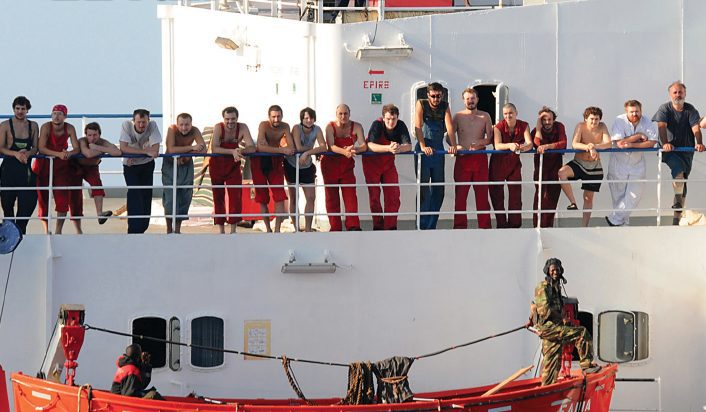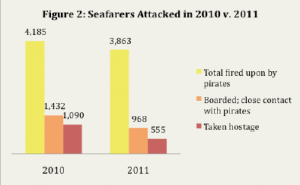Piracy Reporting Centre: Singapore Straits Emerge as Piracy Hotspot
Global piracy and armed robbery incidents against ships have risen sharply in the first quarter of 2025, with a notable 35% increase compared to the same period last year. The...

Seafarers held hostage
Oceans Beyond Piracy, the same advocacy group that calculated the economic cost of piracy by the numbers, has just released its second annual installment of it’s “Human Cost of Piracy” report. The study includes a statistical analysis of the threats of violence caused by acts of piracy and was produced in conjunction with data and information from the International Maritime Bureau.
For the first time, the report publishes findings based on the Declaration Condemning Acts of Violence Against Seafarers, which provides for better reporting of the treatment of hostages. The Declaration, was initially signed in Washington in August 2011 by Liberia, the Marshall Islands, Panama, and then by the Bahamas in March 2012, and commits signatory states to submit reports to the IMB on the treatment of seafarers held hostage.
“Thousands are attacked for financial gain without regard for the human cost to attain a ransom,” says Kaija Hurlburt, Project Manager with Oceans Beyond Piracy co-author of the report. “In 2011, at least 3,863 seafarers were fired upon by Somali pirates armed with assault rifles and rocket propelled grenades. While the number of hostages has gone down over the past year, the violence faced by seafarers has remained high and attacks are often carried out with a determined ferocity – even against vessels protected by private security teams.”
Actually, some of the findings are downright scary, and at times encouraging, depending on how you look at it.
By The Numbers

The report found that a total of 3,863 seafarers were fired upon by Somali pirates, down 8% from 2010. Of those, 968 came in close contact with armed pirates who were able to board their vessels and a total of 413 of them were rescued from citadels by naval forces.
A standout number in the report was that the number of seafarers taken hostage in 2011 dropped by 50% with a total of 555, most likely driven by increased security measures taken by crews including the use of armed. In 2010 a total of 1,090 had been taken hostage.
The report adds that a total of at least 1,206 hostages were held captive by Somali pirates in 2011, including the 555 seafarers who fell victim during 2011, 645 who were captured in 2010 and remained captive in 2011, and 6 tourists and aid workers kidnapped on land. The report estimates that the average length of captivity was over 8 months, up 50% over 2010.
Tragically, 35 hostages died during 2011 including; 8 who were killed by pirates during an initial attack or after being taken captive; 8 died from disease or malnutrition while being held; and 19 died in crossfire while being used as human shields and during hostage rescue attempts. Another 3 hostages died after release as a result of abuse they had suffered while in captivity.
In contrast, it is estimated that 111 pirates were killed in 2011 with 78 killed as a result of encounters with naval forces, 30 killed by fellow pirates, and 3 by Puntland police.
The report also shows that all of the crews were subject systematic and daily psychological and physical abuse. In some cases, the report finds, crews were even being used as human shields.
A former hostage tells us: “One day pirates drew us out to the open deck, told us to turn back and stand still facing the sea side. Then we heard how they reloaded their machine guns. We understood nothing. We saw US Navy not far out and we were standing and waiting for about two hours . . .”
The International Maritime Bureau (IMB) notes in the report the experiences of the seafarers from 23 of the 77 vessels hijacked in 2010 and 2011 based on reports submitted by the Flag States of Liberia, the Marshall Islands, Panama and the Bahamas, various ship owners and operators, former hostages, and by the Maritime Piracy Humanitarian Response Programme.
“Various analyses of the Somali piracy problem have so far ignored a meaningful study into the human cost upon the seafarers and their families,” says Captain Pottengal Mukundan, Director of the IMB.
“This report aims to fill this gap and highlight some of the shocking consequences of this crime upon merchant seafarers, who are in the main, silent, involuntary victims. As other initiatives to counter piracy at sea off Somalia have become established, this important area of support to the victim seafarers and their families remains unaddressed. The challenge of any report of this kind is in getting the victims to recall their painful experiences and report them to help victims in the future.”
Full Report: The Human Cost of Piracy 2011

Sign up for gCaptain’s newsletter and never miss an update

Subscribe to gCaptain Daily and stay informed with the latest global maritime and offshore news


Stay informed with the latest maritime and offshore news, delivered daily straight to your inbox
Essential news coupled with the finest maritime content sourced from across the globe.
Sign Up